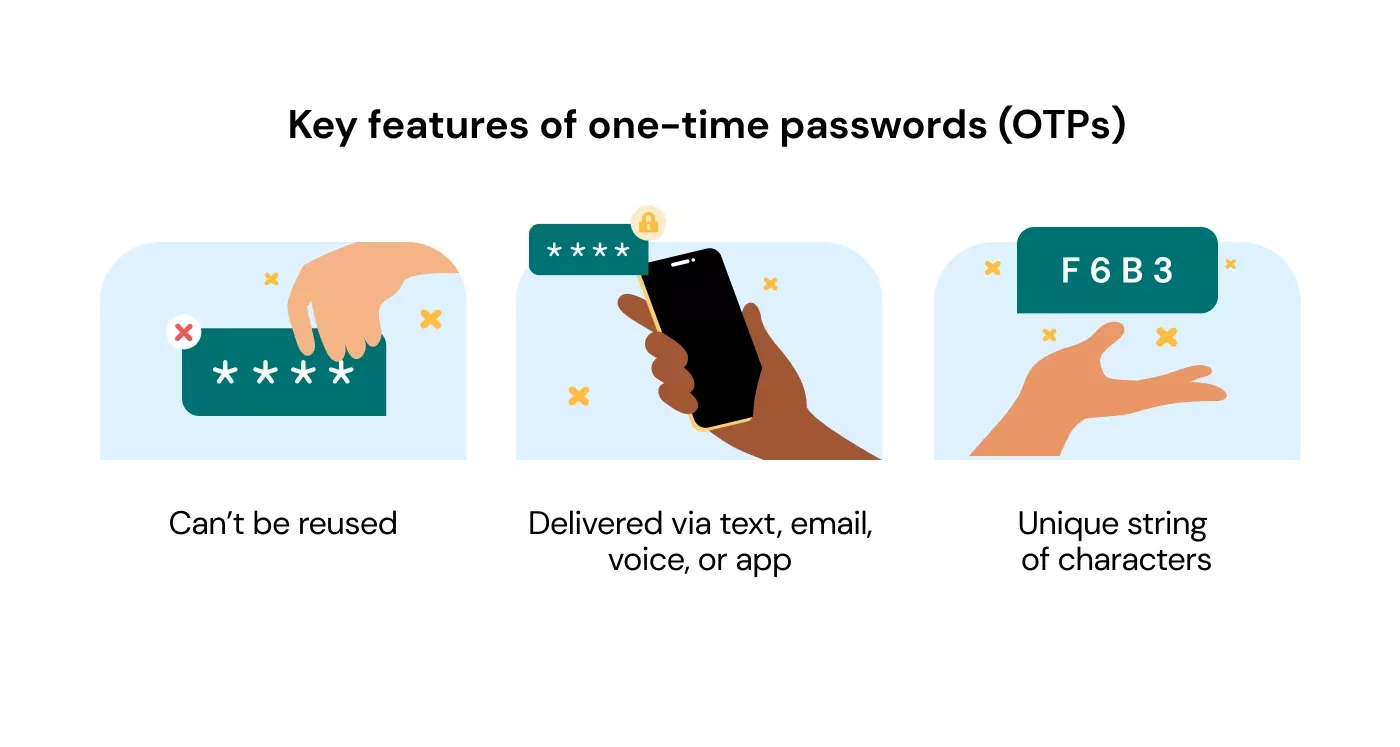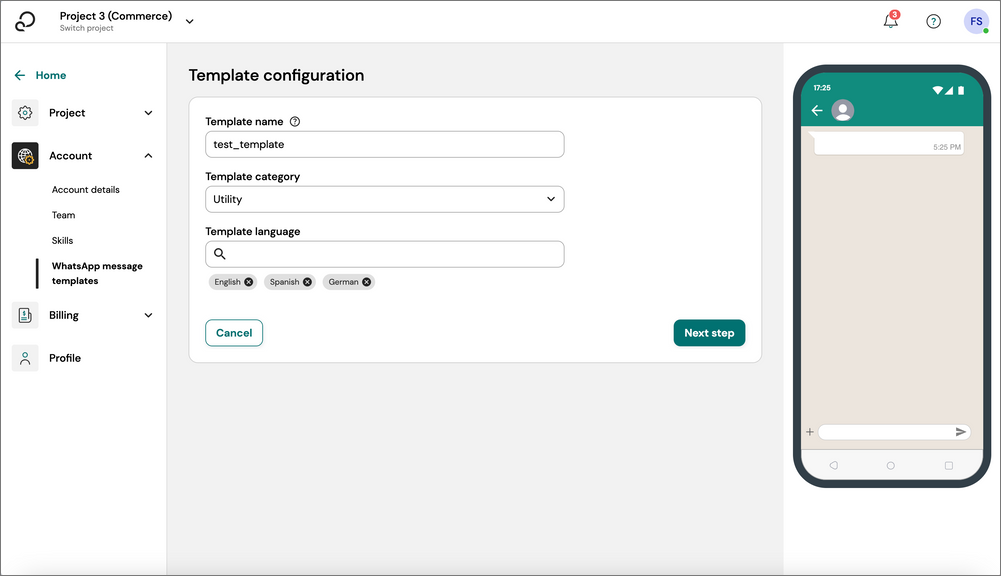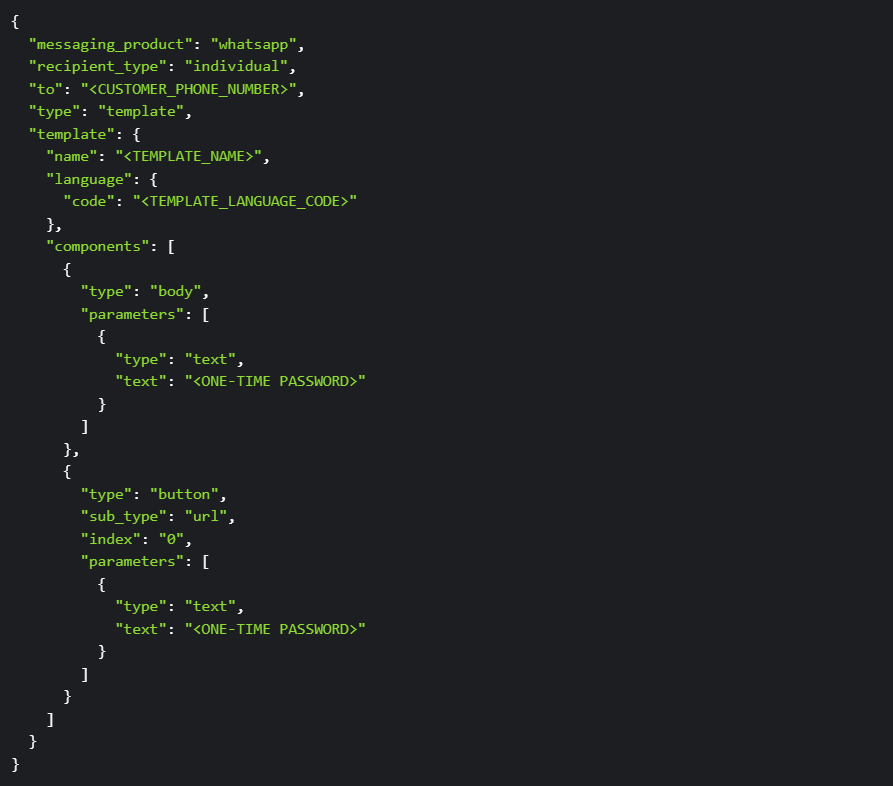One-time passwords have become a very common way for businesses to verify a user's identity in order to help prevent fraud and ensure safe transactions. Typically, OTPs are sent via SMS. But, did you know that you can also use WhatsApp to send an OTP? In the following, we explain how that works, what the advantages of a WhatsApp OTP are, and show you several use cases for your business.
A one-time password (OTP) is a tool to authenticate a user's login, network, or system. It's basically a security check to make sure that the user is who they say they are, and that they have the right to access a platform or information.
Typically, a users makes an entry or login request, and is then sent a password with a unique string of numbers and / or letters. The only way the can log in, is by using that code. As the name says, it's a one-time password, so typically it's only valid for a short period of time. They also can't be re-used.

There are several ways in which companies can send these OTPs: via e-mail, through a phone call, through an authenticator app, as a text message — or as a WhatsApp push notification.
Using WhatsApp for OTPs has several advantages: It's safe, assures high delivery rates, and it can be more cost-effective.
How to send a WhatsApp OTP
Sending a WhatsApp OTP is pretty straightforward, but it requires a WhatsApp Business Platform account because you can only send a one-time passwords through a notification template on the WhatsApp Business API (WhatsApp Business Platform). If you're using the free WhatsApp Business App, you don't have access to the feature.
You get access to the API by building your own IT infrastructure around the interface, through Meta's cloud (both options require IT knowledge and maintenance) or through a WhatsApp Business solution from a certified provider like Sinch Engage (you just use a ready-to-go software, no coding skills required).
Sending an OTP on WhatsApp without coding: Step-by-step guide
Sending a WhatsApp OTP through a messaging software like Sinch Engage is really easy, and only requires a few steps.
1. Set up your template
As with any message that is initiated by a business on the WhatsApp Business Platform, you first need to set up a notification template that then has to be approved. For OTPs, you can either use an existing OTP template or create one from scratch.
To create a new WhatsApp message template on Sinch Engage, go to Settings > Account > WhatsApp message templates. You'll see the template list where you can manage all of the templates in the project.

In order to create a new template, click the Create a template button. The Select pre-made template view opens. For creating a template from scratch, select the first template, which is empty (otherwise, use a pre-made template from the selection).
2. Configurate your template
Once you click on Next step, the Template configuration view opens. Here you can fill in the template name, language, and category. For OTPs, please select "authentication" as category.

3. Get your template approved
Submit your OTP authentication template for approval. This typically takes about 30 minutes. Keep in mind that your own WhatsApp Business number and account must be approved first.
4. Add the OTP to your WhatsApp messages
Once your message is approved, you can proceed to sending out OTPs via WhatsApp. For this, your system or application should generate a one-time password (OTP) for authentication or verification purposes.
Now, insert the OTP into the template. For example, you can have a message like: "Your verification code is: {{e}}."
If you want, you can also add a button to your WhatsApp OTP message. Now, by using the Sinch Engage platform, you can send the template message to the recipient's WhatsApp number.
5. Verification of the OTP
The recipient receives the message containing the OTP on their WhatsApp account, and uses this password for the intended authentication or verification process. You'll get a system message upon success.
Of course, you can also automate this process with a WhatsApp bot.
Sending a WhatsApp OTP by coding yourself
If you are a developer using the WhatsApp API through the Meta Cloud, you'll have to follow Meta's coding instructions for this process.

Keep in mind that you first need to have an approved WhatsApp Business API account and phone number and a verified account.
Now, you can send OTPs to your customers through WhatsApp.
Advantages of WhatsApp OTP
There are several advantages for businesses and customers to sending passcodes through WhatsApp.
Enhanced security
Especially when compared to SMS, WhatsApp OTPs provide an extra layer of security by delivering sensitive verification codes directly to users' WhatsApp accounts.
And while SMS passcodes can be set up in secure ways, it's not the default. SMS settings such as unencrypted messages and an easy backdoor for hackers through the SS7 SMS protocol offer more vulnerabilities than WhatsApp.
Real-time issue resolution
In cases where there are issues with OTP delivery or if users have questions, WhatsApp's chat interface allows real-time communication. Users can respond to the OTP message if they encounter problems, ensuring that their needs are promptly addressed.
No app-switching required
When using WhatsApp OTPs, there's no need for users to switch between applications. They receive the OTP directly in their WhatsApp chat, making the authentication process seamless and user-friendly. This reduces friction and enhances the user experience, especially if you're already communicating with customers on messaging apps like WhatsApp.
Lower costs compared to SMS
Sending SMS messages can be costly, especially when reaching a global audience. WhatsApp OTPs are a cost-effective alternative, particularly for businesses with international users. WhatsApp offers competitive pricing, making it an attractive option for companies of all sizes.
High delivery rates
WhatsApp enjoys high delivery and open rates over 95%. Messages are also less likely to get lost or delayed compared to SMS. Especially if users block unknown numbers, your chances of delivering OTPs can be slimmer than.
SMS fallback
WhatsApp OTPs come with a built-in SMS fallback option. If, for any reason, a WhatsApp message cannot be delivered, the system automatically falls back to sending the OTP via SMS. This redundancy ensures that OTPs reach users, even in challenging network conditions.
Use cases for WhatsApp OTP
WhatsApp OTPs can be employed in various scenarios to enhance authentication and verification processes. Here are some common use cases where WhatsApp OTPs shine:
1. Registration
Streamline the registration process by sending OTPs through WhatsApp, making it easy for users to create accounts and verify their identity.
2. Password reset
Enable secure password resets by sending OTPs to users' WhatsApp accounts, ensuring that only authorized individuals can regain access to their accounts.
3. Transaction verification
Boost security by using WhatsApp OTPs to verify high-value transactions, providing an additional layer of protection for financial and sensitive operations.
4. Account recovery
When users lose access to their accounts, WhatsApp OTPs can be used for account recovery, ensuring that the rightful owner regains access.
5. Two-factor authentication (2FA)
Implement robust two-factor authentication processes with WhatsApp OTPs, offering an extra layer of security for your users.
6. User verification
Verify the authenticity of users, such as drivers, service providers, or sellers, to maintain trust in your platform.
7. Appointment confirmations
Streamline appointment confirmations by sending OTPs via WhatsApp, ensuring that customers can quickly validate their bookings.
8. Ticketing and reservations
Secure ticketing and reservation systems by incorporating WhatsApp OTPs for authentication, making sure that only valid users can access their bookings.
WhatsApp OTPs are versatile and adaptable, making them an excellent choice for a wide range of authentication and verification scenarios.
Making WhatsApp OTPs part of your customer communication strategy
While WhatsApp OTPs can be very functional, they can also be a great building block in your customer communication strategy.
They re-enforce your commitment to security to customers, they make verification processes very efficient, and they also allow for interactions that can lead into other conversations with your customers.
In conclusion, WhatsApp OTP is a game-changer for businesses looking to enhance the security and convenience of their authentication and verification processes.
By integrating WhatsApp OTP into your authentication processes, you're not only safeguarding your users but also providing a seamless and reliable experience.






